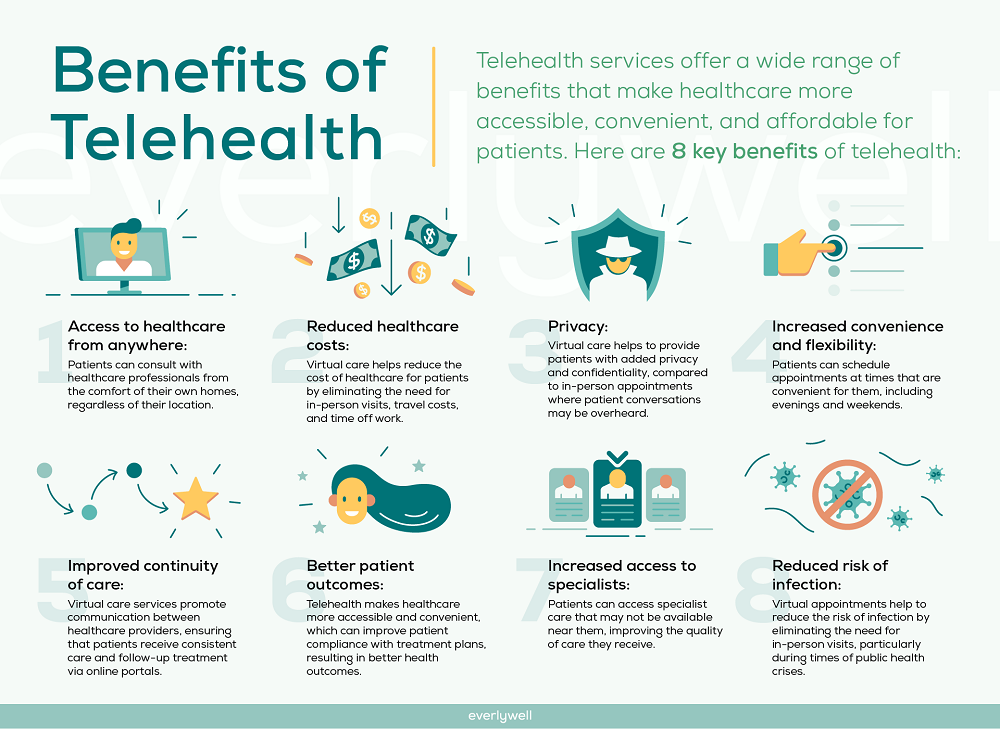
Differences between telehealth vs. in person care
Medically reviewed on November 8, 2022 by Amy Harris, MS, RN, CNM. To give you technically accurate, evidence-based information, content published on the Everlywell blog is reviewed by credentialed professionals with expertise in medical and bioscience fields.
Table of contents
- What is telehealth?
- What is in-person care?
- Comparing telehealth and in-person care delivery
- Experience the quality and comfort of telehealth with Everlywell
- Related content
When it comes to your health, you understandably want the best. With so many different decisions to make, it can be challenging to know if you’re receiving the most appropriate care for your situation.
This desire for the best possible healthcare can be summed up in one modern-day question: when it comes to telehealth vs. in-person care, which one should I pick?
The answer depends on various factors. While these healthcare solutions have plenty in common, they also differ in several ways.
So, what are important differences between telehealth and in person care? Let’s take a closer look at each option before comparing the two.
What is telehealth?
So, what is telehealth, exactly? In a nutshell, telehealth (also called telemedicine) is any form of care that relies on technology to allow patients and healthcare providers to exchange information—without being in the room together. [1]
When most people think of telehealth, they think of video calls with a healthcare professional. And while this medium may be the most familiar, video conferencing is just one of the forms telehealth can take. The three main types of telehealth include synchronous, asynchronous, and remote patient monitoring.
Now that you know what telehealth is, you might wonder, “How do I do a virtual visit with my healthcare provider?” Other modes of telehealth technology include:
- Land or wireless communications – Telephone visits, calls, and texts with healthcare providers also count as telehealth.
- Internet-connected wearables – Today’s smartwatches, pacemakers, and other wearable health technology can upload vital data to an online server for professional analysis.
- Store-and-forward imaging – While video calls allow patients to speak with healthcare providers in real-time, store-and-forward imaging takes an asynchronous approach. With this technology, patients can send photos or videos to a healthcare provider for review in the future.
As technology advances, so do the possibilities for telehealth. You may have already heard about remote surgeries: operations that surgeons can perform while miles away from their patients. [2] This breakthrough technology is just one representation of telemedicine’s potential to change our approach to modern healthcare.

What is in-person care?
In-person care is the “traditional” way to receive healthcare, counseling, and treatment. To seek out in-person care, a patient must travel to a clinic or office to meet with a healthcare provider.
Some clinical procedures that generally still require in-person patient care include:
- X-rays and imaging tests
- Hands-on physical examinations
- Surgeries
Until recently, in-person healthcare has been the standard in medicine because there was no other way to connect patients and healthcare providers. But as technology becomes more accessible to patients worldwide, telehealth is regarded as a valuable complement to in-person appointments.
Comparing telehealth and in-person care delivery
Telehealth and in-person care are equally viable options for anyone looking for clinical support or information. However, just because they’re both reliable doesn’t mean they’re interchangeable.
Below, we’ll review some key differences between in-person care delivery and telemedicine.
Comfort
Perhaps the most noticeable distinction between telehealth and in-person care is patient experience.
In-person medicine requires travel to a physical location. Often, patients must sit in a crowded waiting room or stand in a line before seeing a healthcare provider. Depending on your circumstances, many people find this aspect of in-person visits tiresome, uncomfortable, or even risky.
Telehealth provides a more expedient, efficient, and pleasant patient experience. First, there’s minimal waiting: Your appointment begins when your healthcare provider connects with you via phone or video call.
What’s more, telemedicine enables you to receive medical care and counseling from anywhere. You can take a call from your home, office, or even while on vacation. As long as you have a reliable internet connection, you can receive professional healthcare counseling from anywhere.
Cost
The cost of healthcare can be a major hurdle for many people in the US. Prices can vary widely depending on factors like location, level of service, and preexisting conditions. Once you factor in the cost of health insurance (or lack thereof), copays, and deductibles, even a simple check-in with your healthcare provider can be inaccessible to many.
But can it make a difference if you see your healthcare provider online rather than in-person? A few signs point to "yes":
- Visits – Data from 2017 suggests that the average telehealth visit costs around $79, while the average in-person visit may run you $146. [3] As telemedicine technology continues to develop, these average costs may decrease even more.
- Testing – Prices for tests and screenings reveal a similar trend. For instance, in some places, you might pay as much as $400 for an in-person metabolic blood panel. [4] Compared with at-home testing options, including accessible online results and next-step recommendations, and your budget could feel a major difference between telemedicine and strictly in-person healthcare.
There are also indirect costs associated with face-to-face healthcare. When you visit a healthcare provider in-person, you may incur other expenses going to and from the clinic, such as:
- Parking fees
- Gas for your vehicle
- Tickets for public transit
Many people find in-person healthcare to be a burden on time. Depending on when you schedule an appointment and where you live, you may need to miss out on part or all of a day’s work. If you don’t have paid vacation or sick days, missing a shift can be a significant financial burden. Moreover, if you have a family, you may need to hire childcare while you head in for your appointment.
Overall, when you factor in the potential associated costs of in-person patient care, telehealth is a much more affordable option.
Quality of care
One of the most significant concerns people raise about telehealth is the overall quality of medical care. Patients often wonder how a healthcare provider who can’t physically examine a condition or affected area can accurately assess the problem, or rule out conditions that could be behind a concern.
It’s important to remember that healthcare providers who use telehealth technologies are still trained professionals. A specialist is no less competent over the phone than in-person.
It’s also worth noting that telehealth is nothing new: the notion of virtual care has more than 100 years of history. [5] Ever since humans have been able to communicate over long distances, healthcare providers have been providing advice via radio and telephone.
So, while there are some limitations to a virtual checkup, you shouldn’t worry about a drop in your quality of care. If a remote healthcare provider believes you need a physical exam or further testing, they’ll take action by:
- Providing you with referrals
- Taking the lead charge to help you schedule appointments with specialists and lab techs
- Advising you on the best next steps in diagnosing, managing, and treating a medical condition
At the very least, telehealth appointments work as quick check-ins that can ease your nerves and give you more information.
Ideal uses
The most significant advantage of in-person care is that it can work in almost any situation. Because medicine has been primarily face-to-face for millennia, healthcare providers have established tests and checks for countless illnesses and injuries. In short, when something is wrong, you can rest assured that an in-person provider can look into it—even if they can’t give you a definitive diagnosis or prognosis.
At present, telehealth visits still present some challenges. Video calls and photos can’t be substituted for tests that require physical touch, such as:
- Clinical breast exams (CBE)
- Pap tests or pelvic exams
- Feeling lymph nodes or growths
That said, many exams can be completed virtually by patients with proper instruction and supervision from a healthcare provider. Patients can easily measure their pulse, weigh themselves with a home scale, and even feel for lumps and bumps.
Telehealth excels in any field of medicine that relies on sight or listening to perform exams. Certain disciplines can also be supplemented with at-home tests, including (but not limited to):
- Primary care
- Psychology or psychiatry (mental health counseling)
- Dermatology
- Nutrition and gastroenterology
- Endocrinology
As technology continues to advance, telehealth may soon be an option for even more patient issues. With 3D imaging, artificial intelligence (AI) capabilities, and more, everything from surgery to dentistry could eventually go virtual. And for people who want a greater say in their healthcare, this could be a major advantage.
Experience the quality and comfort of telehealth with Everlywell
The convenience and cost of telemedicine are both appealing, but perhaps the most promising feature of telehealth is its rapid pace of advancement. As more patients and providers embrace the technologies that make telemedicine possible, nearly everyone can take advantage: it’s an equitable healthcare solution that ensures no person is left behind.
Everlywell combines the convenience of telehealth with seamless, at-home wellness testing to support your health and well-being overall. We’ll mail you everything you need to take a sample from home, and you send it back to our CLIA-certified lab. Within days, we’ll update you with your easy-to-understand results and suggested next steps for your health and wellness—no in-person visit required.
The convenience and cost of telemedicine are both appealing, but perhaps the most promising feature of telehealth is its rapid pace of advancement. As more patients and providers embrace the technologies that make telemedicine possible, nearly everyone can take advantage: it’s an equitable healthcare solution that ensures no person is left behind.
With Virtual Care Visits, Everlywell offers convenient telehealth care that lets you speak with a healthcare provider on your schedule and provides you with a care plan which may include testing, prescriptions, and lifestyle recommendations.
Related content
How do I do a virtual visit with my healthcare provider?
Types of telehealth care and services
Can medication be prescribed via telehealth?
How to treat an STI without going to a healthcare provider’s office
STD prescription online: how it works
References
- What is Telehealth? Health Resources Services Administration. URL. Published March 2022. Accessed November 8, 2022.
- Joystick-operated robot could help surgeons treat stroke remotely. MIT News. URL. Published April 13, 2022. Accessed November 8, 2022.
- Can’t see your healthcare provider in person? Take advantage of your telemedicine options. CNBC. URL. Published May 6, 2020. Accessed November 8, 2022.
- They want it to be secret: How a common blood test can cost $11 or almost $1,000. The New York Times. URL. Published March 27, 2020. Accessed October 24, 2022.
- The evolution of telehealth: Where have we been and where are we going? In: The Role of Telehealth in an Evolving Health Care Environment: Workshop Summary. Washington, D.C.: National Academies Press; 2012:11-16.